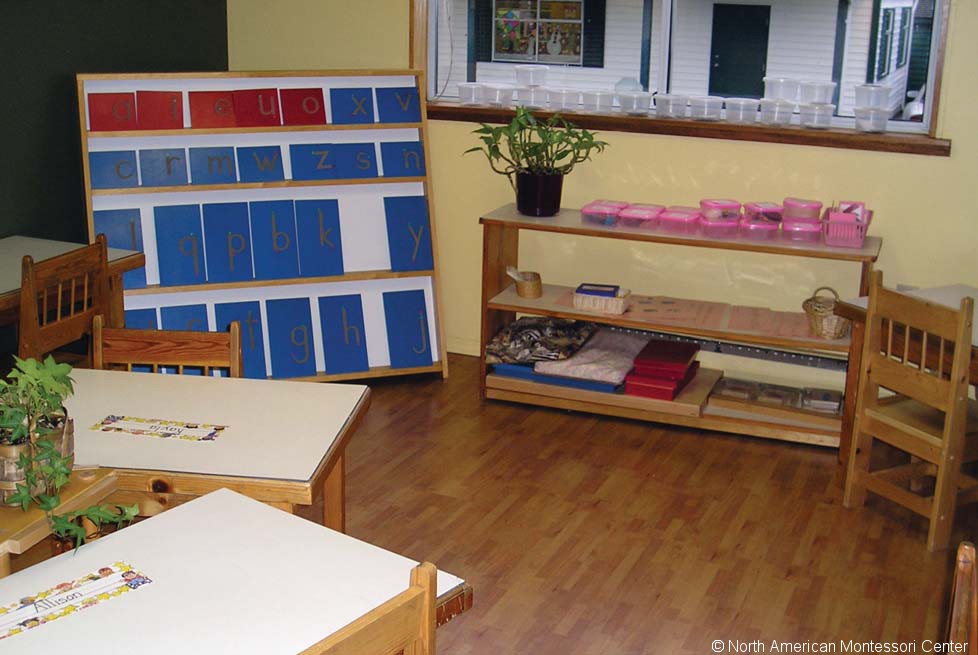
The first aim of the prepared environment is, as far as it is possible, to render the growing child independent of the adult.
—Maria Montessori The Secret of Childhood, 1966.
Montessori’s idea of the prepared environment was that everything the child came in contact with would facilitate and maximize independent learning and exploration. This calm, well-ordered environment has a lot of movement and activity. Children are free to choose and work on activities at their own pace. Here, they experience a combination of freedom and self-discipline, as guided by the environment.
There are generally six aspects, or principles, to the Prepared Environment: Freedom; Structure and Order; Beauty; Nature and Reality; Social Environment; Intellectual Environment. Learn more about each of these aspects, and why the prepared environment is so important to the success a child experiences with Montessori education!
The Six Principles of the Montessori Prepared Environment Explained
1. Freedom
Montessori believed that a child must be free to explore and follow his own natural impulses, thus developing his potential and increasing his knowledge of the world around him. Within the prepared environment, the child must experience freedom of movement, freedom of exploration, freedom to interact socially, and freedom from interference from others. This freedom ultimately leads to a greater freedom: freedom of choice.
2. Structure and Order
While Structure and Order seem counter-intuitive to the aforementioned freedom, nothing could be further from the truth. Structure and Order in the Montessori classroom accurately reflect the sense of structure and order in the universe. By using the Montessori classroom environment as a microcosm of the universe, the child begins to internalize the order surrounding him, thus making sense of the world in which he lives.Montessori stated that there is a sensitive period for order which occurs between the ages of one and three years of age. This is when the child begins to draw conclusions of the world around him. If there is not order to his environment, the child’s sense of reason may be off since he will not be able to validate his findings.
This is not to say that routines or classroom set-up or ways of doing things can't change. However, it does mean that change should be carefully considered. Is this change for the good of the children? If so, it should be done carefully and its after-effects should be observed to ensure that it is of benefit to the children.
3. Beauty
Montessori environments should be beautiful. Whether your school is in an old Victorian mansion or in a strip-mall or in the living room of your home, the environment should suggest a simple harmony. Uncluttered and well-maintained, the environment should reflect peace and tranquility. The environment should invite the learner to come in and work. This atmosphere is easily seen by the attitude of those working there, both child and adult.
4. Nature and Reality
Montessori had a deep respect and reverence for nature. She believed that we should use nature to inspire children. She continually suggested that Montessori teachers take the children out into nature, rather than keeping them confined in the classroom. This is why natural materials are preferred in the prepared environment. Real wood, reeds, bamboo, metal, cotton, and glass are preferred to synthetics or plastics.It is here where child-size real objects come into play. Furniture should be child-size so the child is not dependent on the adult for his movement. Rakes, hoes, pitchers, tongs, shovels should all fit children’s hands and height so that the work is made easier, thus ensuring proper use and completion of the work without frustration.
5. Social Environment
Where there is freedom to interact, children learn to encourage and develop a sense of compassion and empathy for others. As children develop, they become more socially aware, preparing to work and play in groups. This social interaction is supported throughout the environment and is encouraged with the nature of multi-age classroom settings.6. Intellectual Environment
If the above aspects are not recognized, the intellectual environment will not reach its purpose. The purpose of the Montessori environment is to develop the whole personality of the child, not merely his intellect. By guiding the child through the five areas of the Montessori curriculum (Practical Life, Sensorial, Language, Mathematics, and Cultural subjects), the child has the structure which is at the forefront of the creative work in a Montessori classroom.A lot of time and effort is involved in creating a prepared Montessori classroom that is designed to meet the individual needs of all children. Through developmentally appropriate, sensorial material that moves hierarchically from simple to complex and concrete to abstract, children are given the freedom to fully develop their unique potential through a carefully prepared learning environment.
For more information on the Montessori Prepared environment, please see these previous NAMC blogs:
- Montessori Prepared Environment: Purpose, Set-Up and Classroom Features
- Montessori Prepared Environment: Control of Error
- Montessori Prepared Environment: The Montessori Teacher
Detailed information on preparing the Montessori environment for specific age groups is provided in the NAMC Classroom Guides.
As much as possible, NAMC’s web blog reflects the Montessori curriculum as provided in its teacher training programs. We realize and respect that Montessori schools are unique and may vary their schedules and offerings in accordance with the needs of their individual communities. We hope that our readers will find our articles useful and inspiring as a contribution to the global Montessori community.
© North American Montessori Center - originally posted in its entirety at Montessori Teacher Training on Wednesday, March 18, 2009.
© North American Montessori Center - originally posted in its entirety at Montessori Teacher Training on Wednesday, March 18, 2009.

helpful
ReplyDeleteWhat is the principal of prepared environment in relation to movement?
ReplyDeleteVery informative article
ReplyDeleteAmazingly helpful, thank you.
ReplyDeleteAmazingly helpful, thanks a lot.
ReplyDeleteThe six principles of the Montessori prepared environment are very important for children success and it help them to fully develop their potential capability in learning.
ReplyDelete